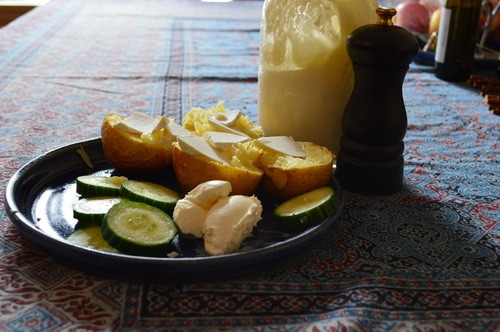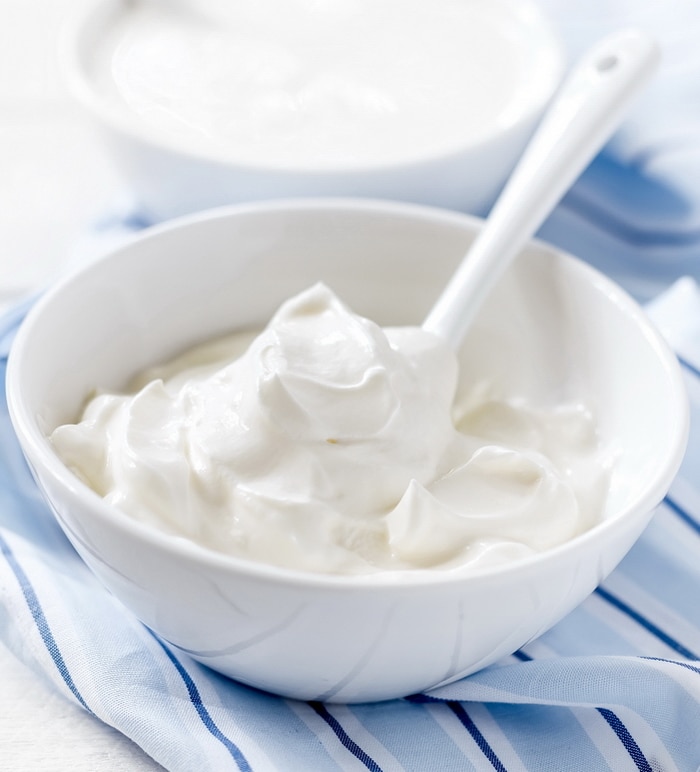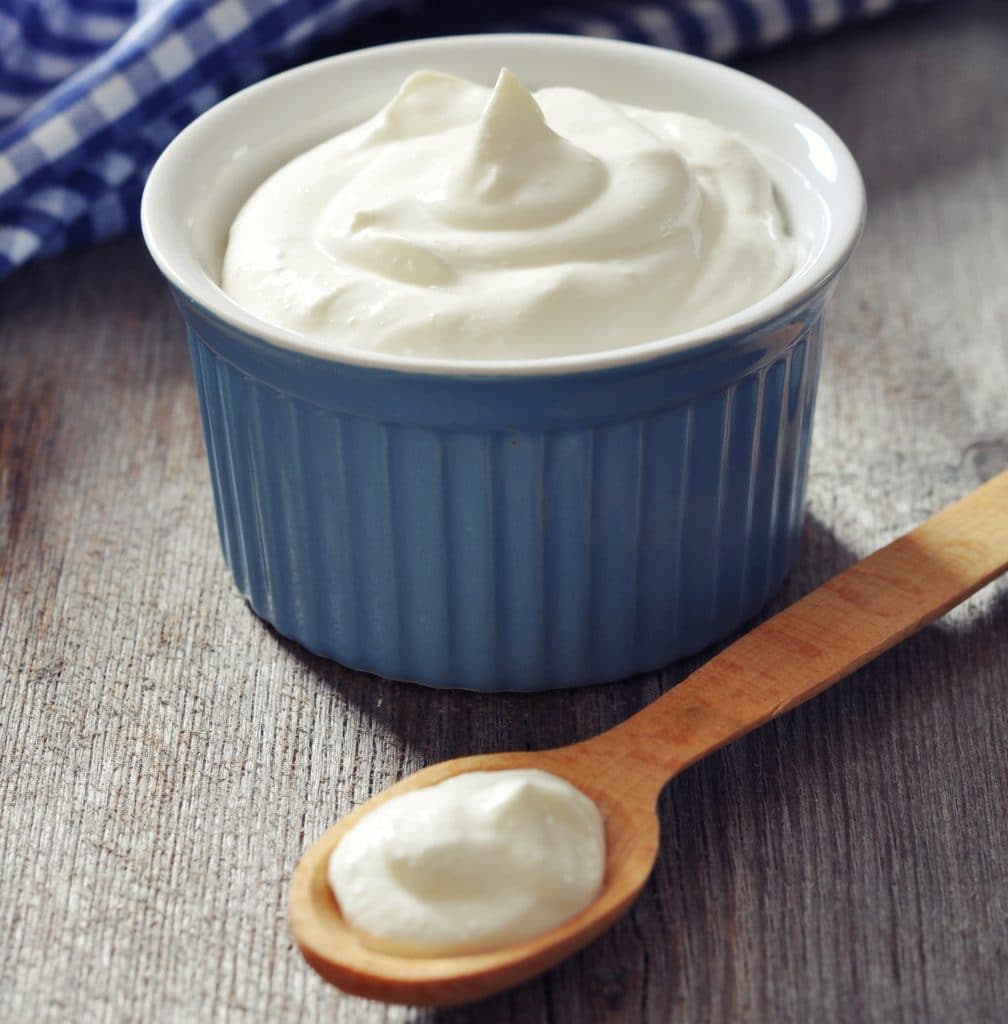How to make sour cream for a fraction of the cost of store-bought, in minutes with this easy recipe. Take advantage of live bacterial cultures, and make this healthy, probiotic dish for yourself.
Sour cream is an easy condiment to make at home. In fact, the hands-on time is less than 5 minutes and the rewards are a rich, creamy probiotic-rich condiment that gives a tang to baked potatoes and dips. It’s so easy to make it at home that I’m surprised anyone would still be buying it in the store.
You can make sour cream at room temperature on the kitchen counter, but a better tasting and more active culture will result from fermenting it overnight in a warm environment. This encourages the proliferation of both mesophilic and thermophilic lacto-bacteria, giving you more probiotics and more complex flavors for the same effort.
Here’s the easy way to use the equipment you already have. You don’t need any special equipment with this method of making sour cream. You’ll need a glass jar with a lid, cheese cloth or a coffee filter, a rubber band or canning jar ring to hold the cheese cloth in place, and a source of consistent heat that can be kept at 100 F. (I use my electric oven, with the light bulb turned on to get just the right temperature to actively ferment the cream.)
The fat content of sour cream comes from the butterfat in the milk. Some people use heavy whipping cream to make it but sour cream can also be made using whole milk, though the consistency will be thinner. Though you may find recipes on the internet claiming to make it by adding a teaspoon of lemon juice, apple cider vinegar, or white vinegar to milk, real sour cream gets its creamy texture, not through the addition of artificial thickeners, but through the addition of a probiotic culture of lactic acid bacteria. Real sour cream tastes sweet and only slightly sour at the same time.
Dairy-free sour cream can be made using the same recipe and substituting cashew cream, coconut milk, or almond milk for the dairy milk in this recipe. Finished sour cream should be placed in the fridge and will keep for a week or two, getting more sour over time. Discard if it grows mold. Learn how to make sour cream by using this recipe that takes advantage of the probiotic benefits of two lactic acid bacterial cultures.


How to Make Probiotic Sour Cream at Home
- Prep Time: 5 minutes
- Cook Time: 8 to 12 hours
- Total Time: 8 to 12 hours
- Yield: 2 cups 1x
- Category: dairy
- Method: ferment
Description
Use this as you would store-bought sour cream on baked potatoes, in stroganoff, as an accompaniment to potato pancakes, as a base for dips or sauces. Once you’ve tasted active, probiotic-rich, creamy homemade sour cream, you’ll never enjoy the commercial product again
Ingredients
- 2 cups of organic, grass-fed heavy cream or half ‘n’ half
- 2 tablespoons of active culture plain yogurt
- ½ teaspoon of mesophilic culture or 2 tablespoons of active cultured buttermilk, or 2 tablespoons milk kefir
- A wide mouth quart mason jar with a lid
Instructions
Step 1: Clean and sanitize both the jar, the lid, and any utensils that will come in contact with the cream.
Step 2: Pour the cream into the sanitized jar. Using a sanitized spoon, stir in ½ teaspoon of the powdered mesophilic culture or 2 tablespoons of the active cultured buttermilk, and 2 tablespoons of yogurt OR omit the mesophilic culture and yogurt and just add 2 tablespoons of kefir. Stir well. Put the lid on the jar.
Step 3: Create a warm environment to culture the sour cream, as you would if you were culturing yogurt. I place a 2-quart glass measuring cup in the oven and put about 1 liter of hot tap water into it. Place the covered jar in this and put it in the oven on the middle rack. Turn the oven light on and close the door. The oven maintains a temperature around 95 to 115 F which is ideal for dairy ferments.
Step 4: Leave the sour cream to ferment overnight – 8 to 12 hours. As it ferments it will thicken and the flavor will improve.
Step 5: Refrigerate the finished sour cream.
Notes
You can make sour cream at room temperature on the kitchen counter, but a better tasting and more active culture will result from fermenting it overnight in a warm environment. This encourages the proliferation of both mesophilic and thermophilic lacto-bacteria, giving you more probiotics and more complex flavor for the same effort.
How to Make Sour Cream
Preparation time: 5 minutes
Fermentation time: 8 to 12 hours

Ingredients:
A wide-mouth quart mason jar with a lid
2 cups of organic, grass-fed heavy cream or half ‘n’ half or whole milk
2 tablespoons of active culture plain yogurt
½ teaspoon of mesophilic culture or 2 tablespoons of active cultured buttermilk, or 2 tablespoons milk kefir

Step by step directions for homemade probiotic sour cream
Yield: 2 cups
Step 1: Clean and sanitize both the jar, the lid, and any utensils that will come in contact with the cream.
Step 2: Pour the mixture into the sanitized jar. Using a sanitized spoon, stir in ½ teaspoon of the powdered mesophilic culture or 2 tablespoons of the active cultured buttermilk, and 2 tablespoons of yogurt OR omit the mesophilic culture and yogurt and just add 2 tablespoons of kefir. (See the explanation below). Stir well. Put the lid on the jar.
Step 3: Create a warm environment to culture the sour cream, as you would if you were culturing yogurt. I place a 2-quart glass measuring cup in the oven and put about 1 liter of hot tap water into it. Place the covered jar in this and put it in the oven on the middle rack. Turn the oven light on and close the door. The oven maintains a temperature around 95 to 115 F which is ideal for dairy ferments.
Step 4: Leave the dairy mixture to ferment overnight – 8 to 12 hours. As it ferments it will thicken and the flavor will improve.
Step 5: Refrigerate the finished sour cream.
Use this as you would store-bought sour cream on baked potatoes, in stroganoff, as an accompaniment to potato pancakes, as a base for dips or sauces. Once you’ve tasted active, probiotic-rich, creamy homemade sour cream, you’ll never enjoy the commercial product again.

A word about active cultures: |
|
Active cultures are living, thriving colonies of Lacto-bacteria. While there are untold numbers of different Lacto-bacteria available – each favoring a different growth medium, in dairy products two major forms of Lacto-bacteria predominate – Mesophilic (used for buttermilk, cheddar, and other hard cheeses) and Thermophilic (used for yogurt, mozzarella, Swiss, and parmesan cheese). Mesophilic Lacto-bacteria include: Lactococcus lactis subsp cremoris, Lactococcus lactis subsp lactis, Lactococcus lactis subsp diacetylactis, and Leuconostoc mesenteroides subsp mesenteroides. Thermophilic Lacto-bacteria include: Streptococcus salivarius subsp thermophiles, Lactobacillus delbrueckii subsp bulgaricus, and Lactobacillus acidophilus. These are the most common bacteria found in commercial cheese making and yogurt making cultures. Mesophilic bacteria reproduce at room temperature around 70 to 78F, while thermophilic bacteria reproduce at temperatures between 105 and 110F. In order for both cultures to reproduce well in your sour cream culture, you need to maintain the temperature in the 100 to 110 range so that both cultures can actively populate your cream. Using both cultures gives your cultured sour cream a more complex flavor. |
| If that seems too complicated and you have access to kefir with active Lacto-bacteria in it feel free to use that instead. Kefir contains both mesophilic and thermophilic Lacto-bacteria. If you are using kefir you do not need yogurt, buttermilk, or mesophilic cultures. |

Trouble Shooting Your Homemade Sour Cream
Why is my sour cream thin?
Your milk may be lacking in sugar, protein or fat. The probiotic bacteria feeds on the sugar in the milk and naturally thickens it. If your finished product is thinner than you want, try it using heavy cream or half in half. Since milk is a natural product the season can affect the milk. Spring milk is usually richer than winter milk. Adding milk powder to the milk can make it richer and result in thicker sour cream as well.
Is sour cream gluten free?
Yes, since the milk is gluten free and the lactic acid bacteria is gluten free, your homemade sour cream will be gluten free.
How should sour cream be stored?
Sour cream is a dairy product and should be refrigerated in an air tight container, after the fermentation is complete. Leaving it at room temperature will encourage proliferation of the mesophilic bacteria leading to a more sour product. However, the milk will eventually separate to curds and whey at room temperature, shortening its shelf life.
Can sour cream be frozen?
Yes, it can be preserved by freezing.
Ways to Use Homemade Sour Cream
You can use your sour cream to make salad dressings like ranch dressing (Add 1/2 cup sour cream, 1/2 cup mayonnaise, 2 tablespoons fresh chives, 1 teaspoon honey to a glass jar. Cover the jar. Shake the mixture to combine. Let it sit for 15 minutes to meld the flavors and serve).
Make sour cream coffee cake or pound cake.
Use your homemade sour cream as the secret ingredient in beef stroganoff or creamy pasta sauce.
How to cook with Homemade Sour Cream
Sour cream, like all cultured milk products, should not be boiled. Add it to the sauce in the last 5 minutes of cooking time. Remove the sauce from the heat and let the active bubbling stop. Stir in sour cream a little at a time with the pan off the heat. This will ensure that it doesn’t separate when it is mixed into the sauce. Serve immediately.
For more posts on home dairy techniques check out these from the archives:
Once you’ve mastered the fermentation technique for making sour cream at home you are ready to add to your dairy ferment repertoire with these recipes. Often the main difference between making sour cream and other fermented dairy products is simply the lactic acid bacteria used in the fermentation.
Making Mizithra Cheese at Home
How to Make Chevre (soft goat cheese)
The Art of Natural Cheesemaking Restores Ancient Cultures




I made this. It isn’t like sour cream at all but a lovely rich and thick yogurt.
Used 2 TB homemade yogurt and 2 TB buttermilk. Checked at 8, 10, and 12 hours.
Mine didn’t thicken. What did I do wrong? I used milk kefir and half & half.
You can pour boiling water over them or if you have a dishwasher, sanitize in the dishwasher.
Can you speak on how you sanitize your tools before you start this? I’m interested, but I don’t want to grow bad stuffs.